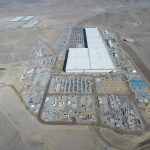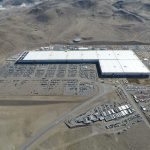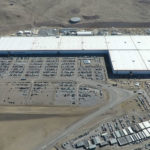Recent aerial photographs obtained by Teslarati show that Tesla’s installation of its rooftop solar array for Gigafactory 1 outside of Reno, Nevada is progressing well. As could be seen in the images, which were taken on March 12, 2018, the California-based electric car and energy company has installed six sets of solar panels on the north end of the facility so far.
Gigafactory 1 was designed with sustainability in mind. Tesla’s description of the sprawling facility alone states that the factory is set to be powered exclusively by renewable energy sources, including a massive solar array that would be installed on its roof. In Tesla’s handout for an investor event, the Elon Musk-led firm described its plans of installing the largest rooftop solar array in the world and the system’s impressive specs. As the facility started taking form, however, the Nevada Gigafactory’s solar panels have proven elusive.
“GF1 is an all-electric factory with no fossil fuels (natural gas or petroleum) directly consumed. We will be using 100% sustainable energy through a combination of a 70 MW solar rooftop array and solar ground installations. The solar rooftop array is ~7x larger than the largest rooftop solar system installed today.”
Leaked images of the first set of solar panels in Gigafactory 1’s roof were released by Building Tesla late last month. The publication, which tracks the progress of Tesla’s structures over time, was able to get a snapshot of the rooftop solar array on February 21, 2018. During that time, only one set of solar panels were completed, and another one was being installed.
If Teslarati’s aerial photos are any indication, it seems like Tesla was able to install almost five more sets of solar panels over the last couple of weeks. Here are the photos we obtained of Gigafactory 1.
- An aerial shot of Tesla’s Gigafactory 1 outside Reno, Nevada, taken during a flyover on March 12, 2018. [Credit: Teslarati]
- An aerial shot of Tesla’s Gigafactory 1 outside Reno, Nevada, taken during a flyover on March 12, 2018. [Credit: Teslarati]
- An aerial shot of Tesla’s Gigafactory 1 outside Reno, Nevada, taken during a flyover on March 12, 2018. [Credit: Teslarati]
- An aerial shot of Tesla’s Gigafactory 1 outside Reno, Nevada, taken during a flyover on March 12, 2018. [Credit: Teslarati]
- An aerial shot of Gigafactory 1 outside Reno, Nevada, taken during a flyover on March 12, 2018 and showing Tesla’s ongoing construction of a rooftop solar array. [Credit: Teslarati]
Now estimated to cost more than $1.3 billion in construction costs, the Nevada Gigafactory is still only a fraction of its planned size. Nevertheless, it is heartening to see that Tesla is starting the construction of the Nevada Gigafactory’s photovoltaic system. It does, after all, fit in well with the company’s current strategy of growing from within and optimizing its existing facilities before expanding its physical footprint.
As we noted in a previous report, Gigafactory 1’s footprint has been the same since August 2017. Reports from Buildzoom, however, reveal that the facility has seen a flurry of activity last year, with the Elon Musk-led firm filing 112 new building permits for Gigafactory 1 in 2017. The improvements, which cost Tesla another 379.9 million, included 50 addendums — enhancements for facilities already in operation — including upgrades for its microgrid laboratory, chiller yard, and general improvements in Sections F and G. A permit for a metrology lab, which would ensure that components are manufactured according to specifications, was also filed.
Currently, the Nevada Gigafactory, which is tasked with the production of the Model 3’s battery packs and drivetrain, boasts a footprint of 1.9 million square feet, with 4.9 million square feet of operational space across several floors. While the now-$1.3-billion facility is already impressive, however, Gigafactory 1 is still only 30 percent complete. Once finished, it is expected to cover an area of 13 million square feet and boast a battery production capacity of 35 GWh annually, making it the largest building in the world by physical footprint.

Cybertruck
Tesla updates Cybertruck owners about key Powershare feature

Tesla is updating Cybertruck owners on its timeline of a massive feature that has yet to ship: Powershare with Powerwall.
Powershare is a bidirectional charging feature exclusive to Cybertruck, which allows the vehicle’s battery to act as a portable power source for homes, appliances, tools, other EVs, and more. It was announced in late 2023 as part of Tesla’s push into vehicle-to-everything energy sharing, and acting as a giant portable charger is the main advantage, as it can provide backup power during outages.
Cybertruck’s Powershare system supports both vehicle-to-load (V2L) and vehicle-to-home (V2H), making it flexible and well-rounded for a variety of applications.
However, even though the feature was promised with Cybertruck, it has yet to be shipped to vehicles. Tesla communicated with owners through email recently regarding Powershare with Powerwall, which essentially has the pickup act as an extended battery.
Powerwall discharge would be prioritized before tapping into the truck’s larger pack.
However, Tesla is still working on getting the feature out to owners, an email said:
“We’re writing to let you know that the Powershare with Powerwall feature is still in development and is now scheduled for release in mid-2026.
This new release date gives us additional time to design and test this feature, ensuring its ability to communicate and optimize energy sharing between your vehicle and many configurations and generations of Powerwall. We are also using this time to develop additional Powershare features that will help us continue to accelerate the world’s transition to sustainable energy.”
Owners have expressed some real disappointment in Tesla’s continuous delays in releasing the feature, as it was expected to be released by late 2024, but now has been pushed back several times to mid-2026, according to the email.
Foundation Series Cybertruck buyers paid extra, expecting the feature to be rolled out with their vehicle upon pickup.
Cybertruck’s Lead Engineer, Wes Morrill, even commented on the holdup:
As a Cybertruck owner who also has Powerwall, I empathize with the disappointed comments.
To their credit, the team has delivered powershare functionality to Cybertruck customers who otherwise have no backup with development of the powershare gateway. As well as those with solar…
— Wes (@wmorrill3) December 12, 2025
He said that “it turned out to be much harder than anticipated to make powershare work seamlessly with existing Powerwalls through existing wall connectors. Two grid-forming devices need to negotiate who will form and who will follow, depending on the state of charge of each, and they need to do this without a network and through multiple generations of hardware, and test and validate this process through rigorous certifications to ensure grid safety.”
It’s nice to see the transparency, but it is justified for some Cybertruck owners to feel like they’ve been bait-and-switched.
Energy
Tesla starts hiring efforts for Texas Megafactory
Tesla’s Brookshire site is expected to produce 10,000 Megapacks annually, equal to 40 gigawatt hours of energy storage.

Tesla has officially begun hiring for its new $200 million Megafactory in Brookshire, Texas, a manufacturing hub expected to employ 1,500 people by 2028. The facility, which will build Tesla’s grid-scale Megapack batteries, is part of the company’s growing energy storage footprint.
Tesla’s hiring efforts for the Texas Megafactory are hinted at by the job openings currently active on the company’s Careers website.
Tesla’s Texas Megafactory
Tesla’s Brookshire site is expected to produce 10,000 Megapacks annually, equal to 40 gigawatt hours of energy storage, similar to the Lathrop Megafactory in California. Tesla’s Careers website currently lists over 30 job openings for the site, from engineers, welders, and project managers. Each of the openings is listed for Brookshire, Texas.
The company has leased two buildings in Empire West Business Park, with over $194 million in combined property and equipment investment. Tesla’s agreement with Waller County includes a 60% property tax abatement, contingent on meeting employment benchmarks: 375 jobs by 2026, 750 by 2027, and 1,500 by 2028, as noted in a report from the Houston Business Journal. Tesla is required to employ at least 1,500 workers in the facility through the rest of the 10-year abatement period.
Tesla’s clean energy boom
City officials have stated that Tesla’s arrival marks a turning point for the Texas city, as it highlights a shift from logistics to advanced clean energy manufacturing. Ramiro Bautista from Brookshire’s economic development office, highlighted this in a comment to the Journal.
“(Tesla) has great-paying jobs. Not just that, but the advanced manufacturing (and) clean energy is coming to the area,” he said. “So it’s not just your normal logistics manufacturing. This is advanced manufacturing coming to this area, and this brings a different type of job and investment into the local economy.”
Energy
Tesla and Samsung SDI in talks over new US battery storage deal: report
The update was related by industry sources and initially reported by South Korean news outlets.

Recent reports have suggested that Tesla and Samsung SDI are in talks over a potential partnership to supply batteries for large-scale energy storage systems (ESS).
The update was related by industry sources and initially reported by South Korean news outlets.
ESS batteries to be built at Samsung’s Indiana plant
As noted in a report from Korea JoongAng Daily, the demand for energy storage systems has been growing rapidly in North America, thanks in no small part to the surge in AI investments across numerous companies. With this in mind, Tesla has reportedly approached Samsung SDI about a potential battery supply deal.
The deal is reportedly worth over 3 trillion Korean won (approximately $2.11 billion) and will span three years, according to The Korea Global Economic Daily. A battery supply deal with Samsung SDI could make sense for Tesla as the company already has a grid-scale battery, the Megapack, which is perfect for industrial use. Samsung SDI could simply supply cells for the EV maker.
Production of the batteries would reportedly take place at Samsung SDI’s joint venture factory with Stellantis in Indiana, which is currently under construction. Samsung SDI recently announced plans to use part of that plant’s EV lines to produce cells for ESS, with a targeted capacity of 30 GWh by the end of next year.
Tesla and Samsung’s partnership
At present, only a handful of manufacturers, including Korea’s LG Energy Solution, Samsung SDI, SK On, and Japan’s Panasonic, are capable of producing energy storage-scale batteries domestically in the United States. A Samsung SDI official issued a comment about the matter, stating, “Nothing has been finalized regarding cooperation with Tesla.”
The possible energy storage system deal adds another layer to Tesla’s growing collaboration with Samsung, which is already in line as a partner in the upcoming production of Tesla’s AI5 and AI6 chips. Early sample manufacturing of the AI6 is expected to begin in South Korea, with mass production slated for Samsung’s Texas-based Taylor foundry when it starts operations.
The AI6 chip will power Tesla’s next wave of high-volume projects, including the Optimus humanoid robot and the autonomous Cybercab service. Musk has called the partnership with Samsung a “real collaboration,” adding that he personally plans to “walk the line” at the Taylor facility to speed up progress.















